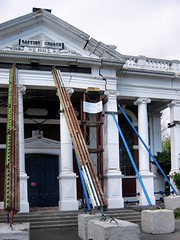
Search
Images for Canterbury Earthquake 2010; more images...
GEER Association Aerial Photograph 104
Images, UC QuakeStudies
An aerial photograph of Canterbury following the 4 September earthquake, taken from a helicopter.
GEER Association Aerial Photograph 103
Images, UC QuakeStudies
An aerial photograph of Canterbury following the 4 September earthquake, taken from a helicopter.
GEER Association Aerial Photograph 101
Images, UC QuakeStudies
An aerial photograph of Canterbury following the 4 September earthquake, taken from a helicopter.
GEER Association Aerial Photograph 129
Images, UC QuakeStudies
An aerial photograph of Canterbury following the 4 September earthquake, taken from a helicopter.
GEER Association Aerial Photograph 112
Images, UC QuakeStudies
An aerial photograph of Canterbury following the 4 September earthquake, taken from a helicopter.
GEER Association Aerial Photograph 098
Images, UC QuakeStudies
An aerial photograph of Canterbury following the 4 September earthquake, taken from a helicopter.
GEER Association Aerial Photograph 113
Images, UC QuakeStudies
An aerial photograph of Canterbury following the 4 September earthquake, taken from a helicopter.
GEER Association Aerial Photograph 131
Images, UC QuakeStudies
An aerial photograph of Canterbury following the 4 September earthquake, taken from a helicopter.
GEER Association Aerial Photograph 099
Images, UC QuakeStudies
An aerial photograph of Canterbury following the 4 September earthquake, taken from a helicopter.
GEER Association Aerial Photograph 127
Images, UC QuakeStudies
An aerial photograph of Canterbury following the 4 September earthquake, taken from a helicopter.
GEER Association Aerial Photograph 096
Images, UC QuakeStudies
An aerial photograph of Canterbury following the 4 September earthquake, taken from a helicopter.
GEER Association Aerial Photograph 116
Images, UC QuakeStudies
An aerial photograph of Canterbury following the 4 September earthquake, taken from a helicopter.
GEER Association Aerial Photograph 106
Images, UC QuakeStudies
An aerial photograph of Canterbury following the 4 September earthquake, taken from a helicopter.
GEER Association Aerial Photograph 136
Images, UC QuakeStudies
An aerial photograph of Canterbury following the 4 September earthquake, taken from a helicopter.
GEER Association Aerial Photograph 108
Images, UC QuakeStudies
An aerial photograph of Canterbury following the 4 September earthquake, taken from a helicopter.
GEER Association Aerial Photograph 120
Images, UC QuakeStudies
An aerial photograph of Canterbury following the 4 September earthquake, taken from a helicopter.
GEER Association Aerial Photograph 095
Images, UC QuakeStudies
An aerial photograph of Canterbury following the 4 September earthquake, taken from a helicopter.
GEER Association Aerial Photograph 122
Images, UC QuakeStudies
An aerial photograph of Canterbury following the 4 September earthquake, taken from a helicopter.
GEER Association Aerial Photograph 130
Images, UC QuakeStudies
An aerial photograph of Canterbury following the 4 September earthquake, taken from a helicopter.
Growing resilient cities: Urban community gardens and disaster recovery af…
Research Papers, Lincoln University
This study explores the role and value of urban community gardens following a major crisis: the 2010/11 earthquakes in Christchurch, New Zealand.
Photo 100
Images, UC QuakeStudies
Damage to a residential property on Hood Avenue in Pines Beach, after the September 4th earthquake. The house is on a lean due to liquefaction.
Photo 037
Images, UC QuakeStudies
A truck laying gravel on the corner of Avonside Drive and Retreat Road, with road cones and "Road Closed" sign, after the September 4th earthquake.
Observed performance of residential masonry veneer construction in the 201…
Research papers, The University of Auckland Library
Following the 2010/2011 Canterbury, New Zealand earthquakes, a detailed door-to-door survey was conducted in the Christchurch region to establish the earthquake performance of lightweight timber-framed residential dwellings with a masonry veneer external cladding system. The post-earthquake survey involved documenting the condition of dwellings in areas that had experienced different levels of earthquake shaking, allowing comparison between the performance of different veneer systems and different shaking intensities. In total, just fewer than 1,100 residential dwellings were inspected throughout the wider Christchurch area. The survey included parameters such as level of veneer damage, type of veneer damage, observed crack widths, and level of repair required. It is concluded that based on observed earthquake performance at the shaking intensities matching or exceeding ultimate limit state loading, the post-1996 veneer fixing details performed satisfactorily and continued use of the detail is recommended without further modification. AM - Accepted Manuscript
this wasn't here when we left
Images, eqnz.chch.2010
Laura and Max return to Christchurch from their holiday in California and inspect the earthquake-caused sand volcano in their front lawn.
Castle Rock scarred
Images, eqnz.chch.2010
The magnitude 7.1 Christchurch earthquake broke off an enormous chunk of Castle Rock in the Port Hills which has tumbled down towards the Lyttelton tunnel. View from Morgan's Valley (-43.578037° 172.714828°).
Photo 033
Images, UC QuakeStudies
NO GO" spray painted on a twisted bridge in Avonside, and cones on the other side, warning people not to cross, after the September 4th earthquake.
NicksPlace Photograph 099
Images, UC QuakeStudies
A fence and Road Closed sign block off an earthquake-damaged road in rural Canterbury.
Elizabeth Ackermann Photograph 021
Images, UC QuakeStudies
A photograph of an office in the Department of Civil and Natural Resources Engineering at the University of Canterbury after the 4 September 2010 earthquake.
Elizabeth Ackermann Photograph 014
Images, UC QuakeStudies
A photograph of an office in the Department of Civil and Natural Resources Engineering at the University of Canterbury after the 4 September 2010 earthquake.
Elizabeth Ackermann Photograph 011
Images, UC QuakeStudies
A photograph of an office in the Department of Civil and Natural Resources Engineering at the University of Canterbury after the 4 September 2010 earthquake.



